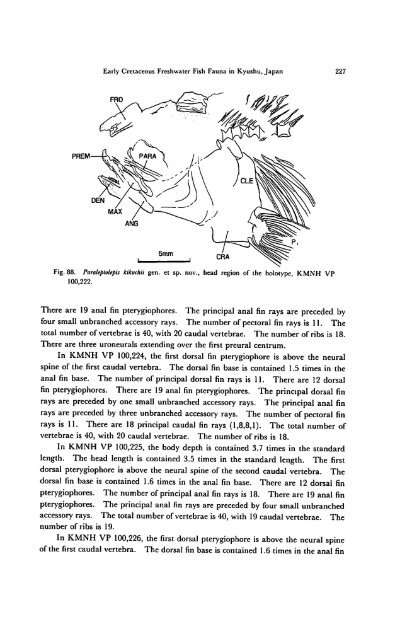Early Cretaceous Freshwater Fish Fauna in Kyushu, Japan
Early Cretaceous Freshwater Fish Fauna in Kyushu, Japan
Early Cretaceous Freshwater Fish Fauna in Kyushu, Japan
You also want an ePaper? Increase the reach of your titles
YUMPU automatically turns print PDFs into web optimized ePapers that Google loves.
<strong>Early</strong> <strong>Cretaceous</strong> <strong>Freshwater</strong> <strong>Fish</strong> <strong>Fauna</strong> <strong>in</strong> <strong>Kyushu</strong>, <strong>Japan</strong> 227<br />
PREM<br />
Fig.88. Paraleptolepis kikuchii gen. et sp. nov., head region of the holotype, KMNH VP<br />
100,222.<br />
There are 19 anal f<strong>in</strong> pterygiophores. The pr<strong>in</strong>cipal anal f<strong>in</strong> rays are preceded by<br />
four small unbranched accessory rays. The numberof pectoral f<strong>in</strong> rays is 11. The<br />
total number ofvertebrae is 40, with 20 caudal vertebrae. The number of ribs is 18.<br />
There are three uroneurals extend<strong>in</strong>gover the first preural centrum.<br />
In KMNH VP 100,224, the first dorsal f<strong>in</strong> pterygiophore is above the neural<br />
sp<strong>in</strong>e of the first caudal vertebra. The dorsal f<strong>in</strong> base is conta<strong>in</strong>ed 1.5 times <strong>in</strong> the<br />
anal f<strong>in</strong> base. The number of pr<strong>in</strong>cipal dorsal f<strong>in</strong> rays is 11. There are 12 dorsal<br />
f<strong>in</strong> pterygiophores. There are 19 anal f<strong>in</strong> pterygiophores. The pr<strong>in</strong>cipal dorsal f<strong>in</strong><br />
rays are preceded by one small unbranched accessory rays. The pr<strong>in</strong>cipal anal f<strong>in</strong><br />
rays are preceded by three unbranched accessory rays. The number of pectoral f<strong>in</strong><br />
rays is 11. There are 18 pr<strong>in</strong>cipal caudal f<strong>in</strong> rays (1,8,8,1). The total number of<br />
vertebrae is 40, with 20 caudal vertebrae. The number of ribs is 18.<br />
In KMNH VP 100,225, the body depth is conta<strong>in</strong>ed 3.7 times <strong>in</strong> the standard<br />
length. The head length is conta<strong>in</strong>ed 3.5 times <strong>in</strong> the standard length. The first<br />
dorsal pterygiophore is above the neural sp<strong>in</strong>e of the second caudal vertebra. The<br />
dorsal f<strong>in</strong> base is conta<strong>in</strong>ed 1.6 times <strong>in</strong> the anal f<strong>in</strong> base. There are 12 dorsal f<strong>in</strong><br />
pterygiophores. The number of pr<strong>in</strong>cipal anal f<strong>in</strong> rays is 18. There are 19 anal f<strong>in</strong><br />
pterygiophores. The pr<strong>in</strong>cipal anal f<strong>in</strong> rays are preceded by four small unbranched<br />
accessory rays. The total number of vertebrae is 40, with 19 caudal vertebrae. The<br />
number of ribs is 19.<br />
In KMNH VP 100,226, the first dorsal pterygiophore is above the neural sp<strong>in</strong>e<br />
of the first caudal vertebra. The dorsal f<strong>in</strong> base is conta<strong>in</strong>ed 1.6 times <strong>in</strong> the anal f<strong>in</strong>

















